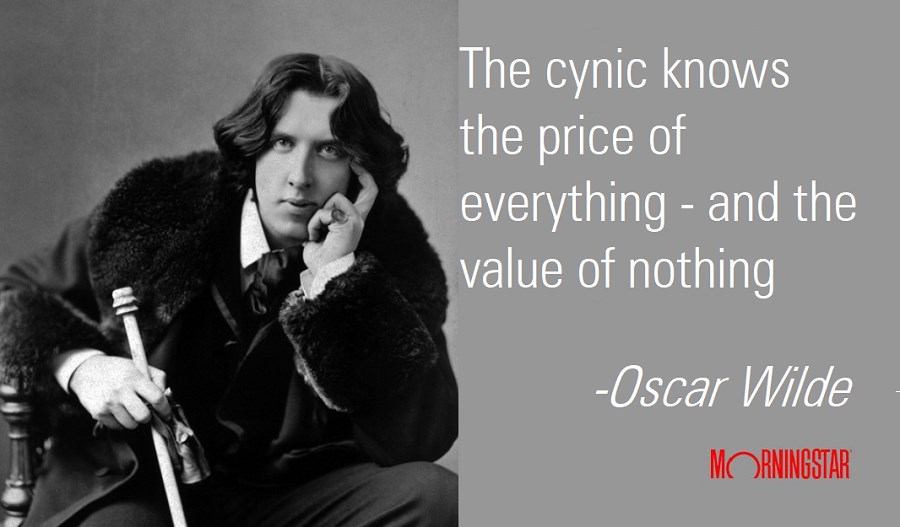
A reader recently wrote in asking for some advice on her stock portfolio. Her husband had just died, and she wanted to know which of his stocks she should hold and which she should sell. She wrote, “I feel I should sell the cheap ones, especially the ones below $20 per share or so?”
She isn’t alone in her misconception of stock prices. Many investors assume that if a stock price is low, it is cheap, and that if a price is high, the stock is expensive. The assumption here is that the stock's price is an accurate reflection of the value of a company.
Without context, non-investors will likely assess a stock price in the same way they assess the price of any other consumer good, for example, shoes. You can get a pair of trainers for £20 or you could get shell out for the Nike MAG Back to the Future trainers, which go for around £24,000. We can agree that £20 trainers are inexpensive and £24,000 ones are very expensive. This is because our concept of the value of something is based on our ability to gauge price versus value for consumer goods. We think harder about spending £1,000 on a physical thing (or service) than we do about spending £10.
Because we think like this and make these judgments often in our daily lives, it is natural for us to extend this logic to stocks. To our minds, a stock under £10 is cheap, while one over £1,000 is expensive.
But this is just not true.
What is important about understanding stock prices is that stocks are not like any other product or commodity we buy. The only thing the price of a share in a company and the price of a consumer good have in common is the unit of measurement in which they are expressed.
A company is cheap, or undervalued, when the share price is lower than its intrinsic value. On the flip side, a company is expensive, or overvalued, when the stock price is higher than its intrinsic value.
Let’s break that down to understand what each of these terms mean.
What is a Stock or Share?
When you own a share of a company, it means you are entitled to own a share of that company’s future profits (or, in the case of a liquidation, a share of its remaining assets).
You can own a share in a company even if its shares are not publicly traded. Family businesses work exactly this way, for example: family members own a certain share of the business, which is usually expressed as a percentage. In private company legal documents, though, the ownership is expressed in shares, just as with publicly traded companies.
Publicly traded companies usually have millions of shares outstanding. The percentage you own of the company is simply the number of shares you own divided by the total shares outstanding. Shares outstanding can be found on every company profile page on Morningstar.
What is a Stock (or Share) Price?
A stock price is the price of a single share of stock of a company.
The price of a share indicates what the market – made up of buyers and sellers – thinks the current value of the company is. It represents the price at which the stock will trade. Put another way, it is an agreement of the price between the buyer and the seller of the stock – it is both the highest price that a buyer is willing to pay and the lowest price at which a seller is willing to sell.
This also means that the number of buyers and sellers matters. If there are more people willing to sell the stock than willing to buy, the price falls. If there are more people willing to buy the stock than willing to sell, the price rises. The stock price is not only dependant on what the company is doing but also on the feelings or sentiments of the buyer and the seller. And these feelings often have nothing to do with the value of the company at all.
What is Intrinsic Value?
The value, or intrinsic value, of a company is a measure or assessment of what the company is worth. The most important thing to remember is that a company’s value is always an estimate – there is no one answer or single number that captures value. It’s a probabilistic assessment performed by human analysts of the outcomes that the company may achieve in the future. No one knows the future of anything, but, given the risks and rewards of investing, assessing the probable outcomes is an activity worth pursuing.
Our Fair Value Estimate is the outcome of the rigorous process we employ to analyse companies. The Fair Value Estimate is a measuring stick for determining long-term intrinsic value. It tells investors what we think the long-term intrinsic value of a stock is and helps them see beyond the current market price.
Our stock analysts calculate the fair value estimate of a company based on how much cash we think the company will generate in the future. When determining the fair value estimate, we also take into account the predictability of a company's future cash flows.
The Key to Understanding Stock Prices Vs Value
In many cases, the stock price does not accurately reflect the intrinsic value of the company. More often than not, a stock will trade below or above its intrinsic value. So, looking at only price when deciding on a stock to buy is not useful when observing stock prices, because:
(a) investing is not spending, and
(b) the unit of the “thing” you’re buying when you buy a share is the present value of the company’s future earnings.
Let’s look at some examples.
| Company | Economic Moat | Price | Fair Value Estimate | P/FV | Morningstar Star Rating | Consumer Verdict | Investor Verdict |
| Berkshire Hathaway B | Wide | 208 | 228 | 0.91 | *** | Looks expensive but way cheaper than BRK.A. | Fairly priced; slight discount. Its price and valuation are virtually identical to A’s. |
| Berkshire Hathaway A | Wide | 313,419 | 342,500 | 0.91 | *** | Outrageously expensive! They must think I’m an idiot. Maybe I’ll buy some B shares. | Fairly priced; slight discount. Its price and valuation are virtually identical to B’s. |
| Infosys | Narrow | 13 | 9.20 | 1.40 | ** | Looks cheap! | Au contraire--quite expensive. |
| Experian | Wide | 37 | 26 | 1.42 | * | Seems reasonable. I can buy almost 300 shares for $10,000! | At least 40% overvalued. |
| Biogen | Wide | 289 | 389 | 0.74 | **** | Too rich for my blood! I’d need almost $30,000 to buy 100 shares! | This is quite a bargain, especially considering its wide, stable moat. |
Morningstar Direct Data as of Aug. 19, 2020.
So you see, a low price does not mean good value and a high price does not necessarily mean low value.
One classic example of this disconnect is the case of the stock price movement of the now-bankrupt Hertz Global Holdings (HTZ). The car rental company started the year well, with its stock trading near $20 per share in February. But then the coronavirus pandemic struck. With almost everyone in lockdown, no one needed a rental car, and Hertz ended up with around 700,000 cars sitting idle – meaning it had low to no revenues – and close to $20 billion in debt. The company was in bad shape, and in May 2020, filed for bankruptcy protection from its creditors.
The stock price briefly reflected this dismal situation, falling as low as $0.56 per share. But then something strange happened. Investors, many of them first-timers or new investors without much experience in the stock markets, noticed this “cheap” stock price. The sense was that the price had already fallen so low that there was only one way to go from here, and that was up! So, many investors bought in, thinking they could make a quick buck trading the Hertz stock. In just two weeks, the stock price of Hertz moved from less than $1 to around $5.5 per share. Then, it immediately began falling until it settled around $1.5 per share, where it is today.
Through this rollercoaster ride, the fundamentals of the company did not change. Arguably, the company’s intrinsic value was the same as it was when it initially filed for bankruptcy. But this was not reflected in the share price. The share price of Hertz fluctuated wildly over a short period of time, moving higher and lower to indicate the price that buyers and sellers were willing to pay for the stock, not the value of the company itself.
Put another way, the buyers and sellers of Hertz stock were gambling on the outcome of a short-term occurrence – Hertz’s bankruptcy protection – not investing in the company’s long-term prospects.
So You Want To Be a Stockpicker
The stock price is only one of many factors that investors should consider when deciding what stocks to buy. At Morningstar, we look for a competitive advantage, or an economic moat, which we measure with the Morningstar Economic Moat Rating. A company with an economic moat can fend off competition and earn high returns on capital for many years to come. We also consider margin of safety and the company’s valuation.
At Morningstar, we love a good deal. As stockpickers, our goal is to find companies that are trading at a price that is lower than their intrinsic value –undervalued companies. The Morningstar Rating for stocks, or “star rating,” can help investors uncover stocks that are truly undervalued. The rating is determined by three factors: a stock's current price, Morningstar's estimate of the stock's fair value, and the uncertainty rating of the fair value. The bigger the discount, the higher the star rating. Four- and 5-star ratings mean the stock is undervalued, while a 3-star rating means it is fairly valued, and 1- and 2-star stocks are overvalued. When looking for investments, a 5-star stock is generally a better opportunity than a 1-star stock.
Don’t Forget Risk
When investing, one of your main priorities should be to determine how much risk to take. You need to assess your risk capacity, which helps you understand the optimal amount of risk you could take in order to maximize the chance that you reach your goal.
Investors often mistakenly believe that high risks equal higher returns. This is a myth. This is true only in the case of efficient portfolios, which are highly diversified. These efficient portfolios have the highest level of expected return possible given their risk. If you already hold an efficient portfolio, the only way to increase your return is to increase your risk.
And remember, this does not mean you will have higher returns, just that you will have higher potential returns. You could also have higher potential losses. This was the case with investors who tried to bet on Hertz. Sure, if you bought at $0.5 per share, the investment rose to $5.5 per share but then also crashed to $1.5 per share.
Before taking more risk, build an efficient portfolio. Invest across asset classes and diversify within each class.
This article first appeared on Morningstar Canada



















